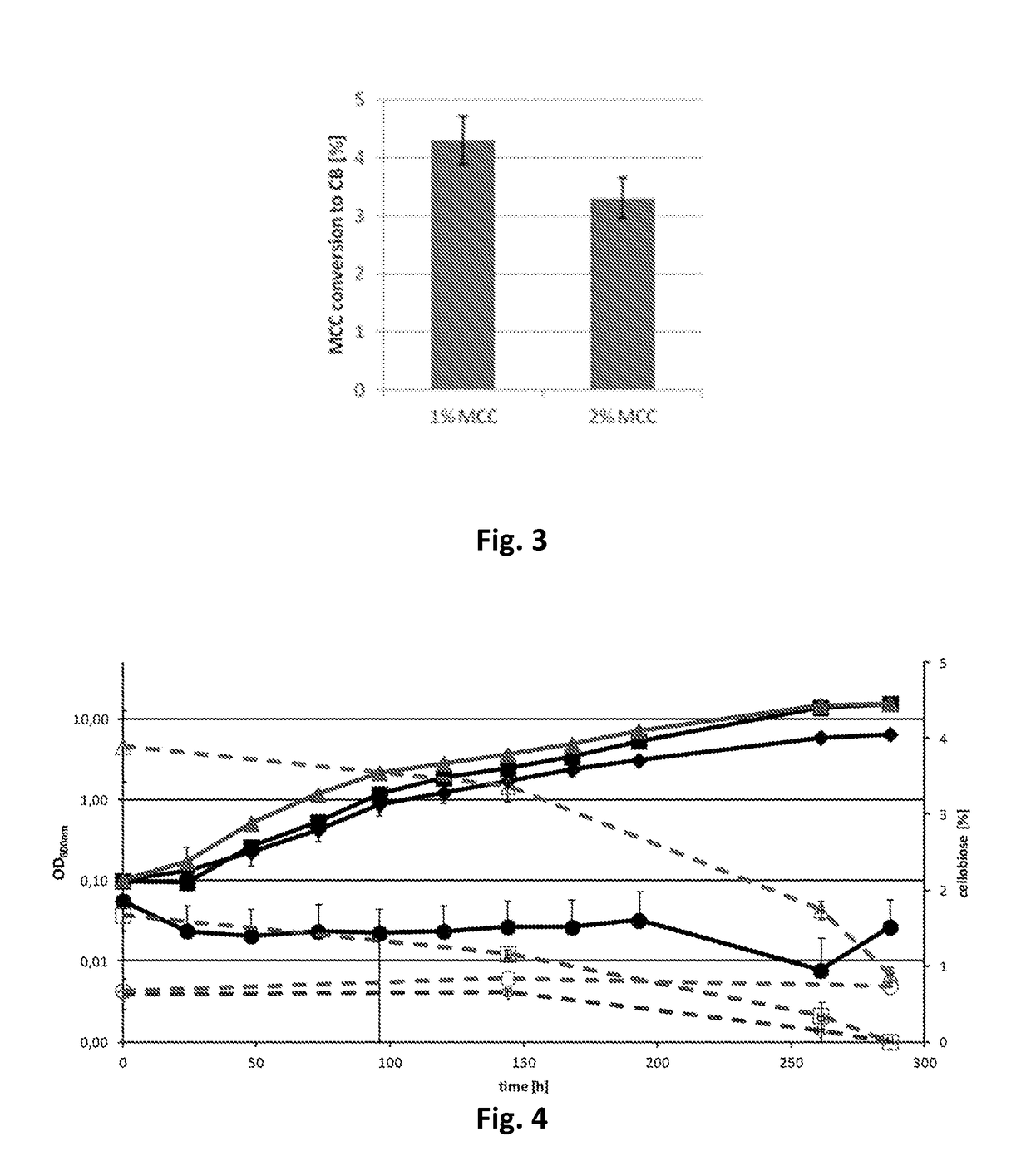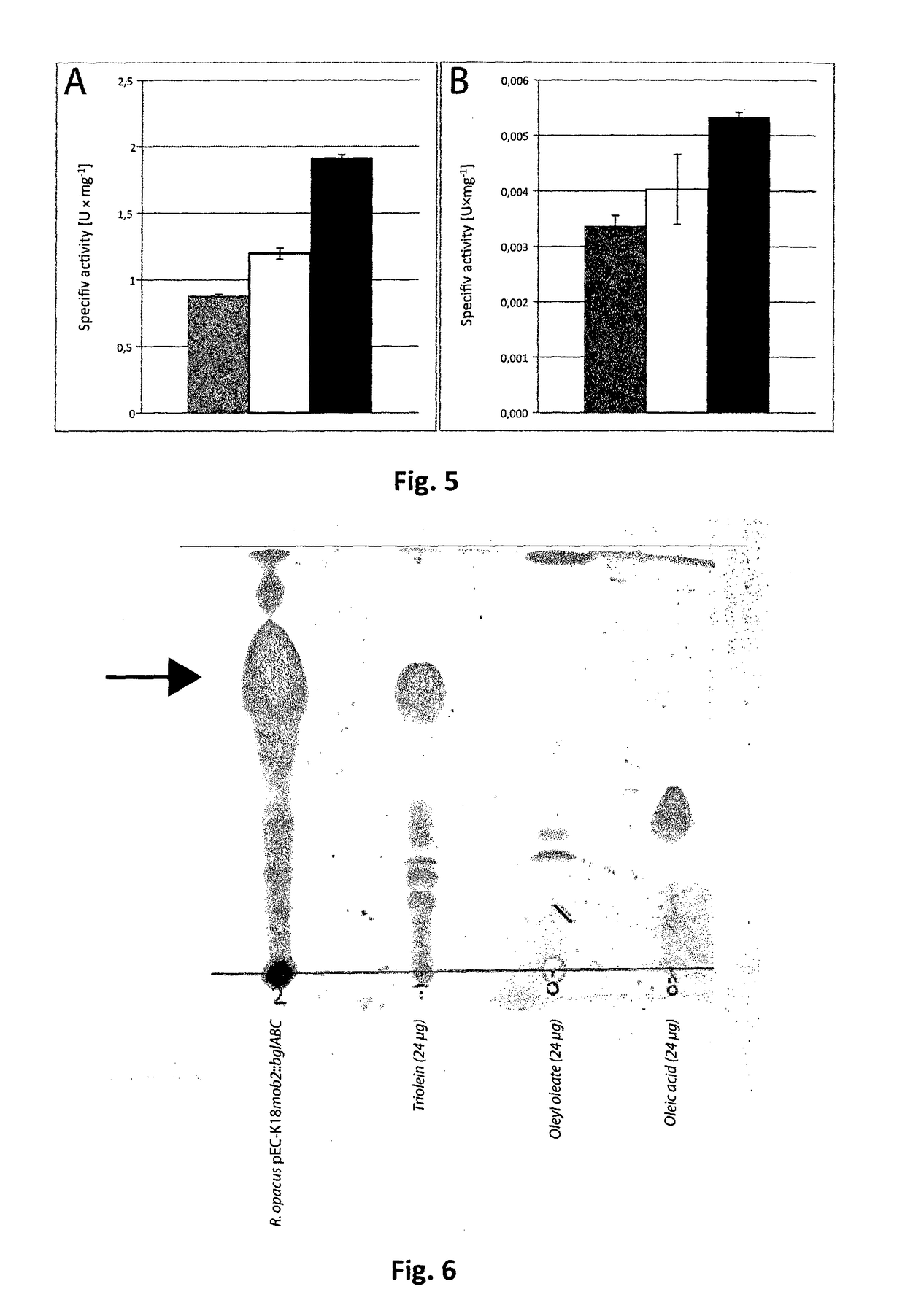Oleaginous bacterial cells and methods for producing lipids
a technology of oleaginous bacterial cells and lipids, applied in the field of oleaginous bacterial cells and methods for producing lipids, can solve the problems of strains that cannot hydrolyze cellobiose into its glucose monomers, complex lignocellulose materials and their resistance to biodegradation, and major expense factors, so as to achieve cost-efficiency improvement
- Summary
- Abstract
- Description
- Claims
- Application Information
AI Technical Summary
Benefits of technology
Problems solved by technology
Method used
Image
Examples
example 2
Analysis of Cellulases
[0137]In order to proof if the cellulases are translocated through the membrane or if the cellulase activity in the medium is the result of cell death and subsequent leakage of the enzyme by cell lysis, the signal peptide as predicted by SignalP (Petersen, Brunak, von Heijne, & Nielsen, 2011) and previous determinations (Wong et al., 1986) was omitted from cenA by PCR and the product was ligated to vector pEC-K18mob2, yielding plasmid pEC-K18mob2::cenA-SP. The plasmid was transferred to E. coli Mach1-T1 and R. opacus PD630 and the cellulase-activity was determined. Neither colonies of recombinant E. coli nor R. opacus PD630 exhibited clear zone formation on MSM plates containing 1% (wt / vol) CMC after 2 days of incubation in contrast to the control strains harboring pEC-K18mob2::cenA (FIG. 13).
[0138]To check whether the modified CenA is active or not, the soluble cell and membrane fraction of disrupted R. opacus PD630 pEC-K18mob2::cenA-SP cells was screened for ...
example 3
ve Cellulase Activity Assay
[0142]Qualitative analysis of cellulase activity was done as described by (Beguin, 1983). In brief, recombinant strains of R. opacus PD630 harboring cellulases were incubated on MSM plates containing 0.5% (wt / vol) carboxymethyl cellulose (CMC) at 30° C. for 2 days. Directly thereafter the plates were stained with a 0.1% (wt / vol) Congo red solution for 5 minutes. Destaining was done with a 1 M NaCl solution until clear zones were visible.
[0143]All tested cellulases exhibited activity, visible by clear zone formation on MSM plates containing 0.5% (wt / vol) carboxymethyl cellulose (CMC) after staining with Congo red, and the corresponding plasmids were subsequently transferred to R. opacus PD630. Interestingly, no transformants could be obtained neither for plasmid pEC-K18mob2::cenB nor the double construct pEC-K18mob2::cenBA. In contrast to the tested recombinant E. coli strains, all plasmids with the exception of plasmid pEC-K18mob2::cbhA (FIG. 11) and pEC-K...
example 4
ive Determination of Enzyme Activities
[0144]Cells of R. opacus PD630 were cultivated at 30° C. in mineral salts medium (MSM) as described by (Schlegel, H. G., Kaltwasser, H., and G. Gottschalk, 1961). Carbon sources were added to liquid MSM as indicated in the text. Liquid cultures in Erlenmeyer flasks were incubated on a horizontal rotary shaker at an agitation of 110 rpm. Solid media for qualitative cellulase assay were prepared by addition of 1.5% (wt / vol) agar / agar.
[0145]Cells of Escherichia coli were cultivated at 37° C. in Lysogeny Broth (LB, (Bertani, 2004)). Cells of Thermobifida fusca DSM43792 were grown in Czapek peptone medium at 42° C. (Waksman, 1961) and cells of Cellulomonas fimi ATCC484 were grown in Standard I medium at 30° C. (Carl Roth, Karlsruhe, Germany). Antibiotics were applied according to (Sambrook, Fritsch, & Manitas, 1989) and as indicated in the text.
[0146]To quantify cellulase activities in the culture medium of recombinant strains, cells were cultured in...
PUM
| Property | Measurement | Unit |
|---|---|---|
| temperatures | aaaaa | aaaaa |
| w/w | aaaaa | aaaaa |
| w/w | aaaaa | aaaaa |
Abstract
Description
Claims
Application Information
 Login to View More
Login to View More - R&D
- Intellectual Property
- Life Sciences
- Materials
- Tech Scout
- Unparalleled Data Quality
- Higher Quality Content
- 60% Fewer Hallucinations
Browse by: Latest US Patents, China's latest patents, Technical Efficacy Thesaurus, Application Domain, Technology Topic, Popular Technical Reports.
© 2025 PatSnap. All rights reserved.Legal|Privacy policy|Modern Slavery Act Transparency Statement|Sitemap|About US| Contact US: help@patsnap.com



